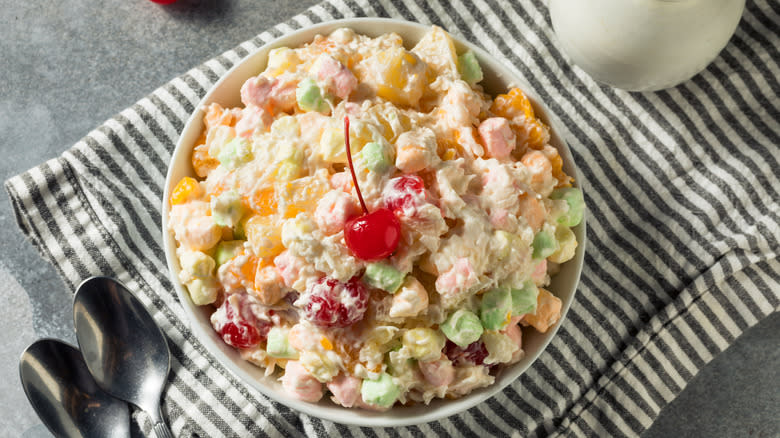How Cool Whip Differs From Whipped Cream

Whether you're topping ice cream, cake, pie, or a bowl of peak-season fruit, there's always room for a creamy whipped topping at dessert. Or even on the dinner table if ambrosia salad is on the menu. It's hard to top homemade whipped cream, but if you're looking for a more convenient (read: store-bought) option, there's another luscious choice that tops the list: Cool Whip. In fact, Cool Whip products were eaten by almost twice as many consumers as Reddi Wip products in 2020.
At first glance, whipped cream and Cool Whip seem pretty similar. They're both white, fluffy, and sweet, spooned over treats as a cool and velvety finishing touch. Upon closer inspection, these two products don't have much in common at all. From ingredients and preparation to storage and nutritional value, Cool Whip and whipped cream are two sides of a dessert-topping coin. Yes, they're both delicious, but here's what sets these products apart.
Read more: 23 Best Ice Cream Brands Ranked
What Is Whipped Cream?

Whipped cream is the OG dessert topping. As the name implies, whipped cream is cream that has been whipped. Heavy cream is chilled, then vigorously whipped with a whisk or electric mixer to introduce air, which creates tiny bubbles trapped by fat and protein to produce smooth and voluminous results.
That combination of fat, protein, and temperature stabilizes whipped cream, meaning it is sensitive to temperature and time — if your whipped cream gets too warm or sits out for too long, you'll lose your lift. You can, however, use instant pudding mix or gelatin to give those bubbles some added strength and stability.
Because whipped cream is more delicate, it is best made just before serving. Chill your cream, bowl, and utensils, and have any flavorings ready to go. Beat the cream to soft peaks before adding your sweetener, then continue to whip to your desired consistency. Homemade whipped cream can be kept in the refrigerator for a day or two before it begins to deflate.
If you want the rich, creamy flavor of whipped cream without the last-minute work, grab a can of whipped cream from your grocery store's dairy section. Unlike Cool Whip, Reddi Wip is made with real cream and milk, and doesn't include hydrogenated oils. Canned whipped cream has about 20 calories per two tablespoons (which is almost identical to the calories per serving of Cool Whip), versus 100 calories for two tablespoons of the homemade stuff.
What Is Cool Whip?

It took a prolific food chemist to figure out how to give creamy whipped toppings a longer shelf life. In 1966, William A. Mitchell — the same chemist who invented TANG and Pop Rocks — found the perfect combination of ingredients to make a light, fluffy, spoonable topping that can be stored in the freezer.
Sure, there's more high fructose corn syrup and hydrogenated oils than there is milk (and even less cream!), but it's hard to deny the perfect consistency and incredible convenience of Cool Whip. Plus, Cool Whip is a low-calorie alternative to homemade whipped cream (Cool Whip has only 25 calories per serving vs. whipped cream's up to 100 calories), especially if you opt for a reduced-fat or fat-free version.
Another notable difference between Cool Whip and whipped cream is the texture. Whipped cream is light, fluffy, and airy, while Cool Whip has an almost marshmallowy texture. It's a little more firm and is often sweeter than homemade whipped cream.
Cool Whip can be used just like whipped cream, spooned over your favorite desserts or into hot chocolate. Because there are stabilizers included, Cool Whip is also a popular choice for no-bake pies and nostalgic dishes like Watergate Salad or a decadent jello mold. No matter how you scoop it, Cool Whip is worth keeping in your freezer to have a delicious dollop on-hand whenever the mood strikes.
Read the original article on Tasting Table
